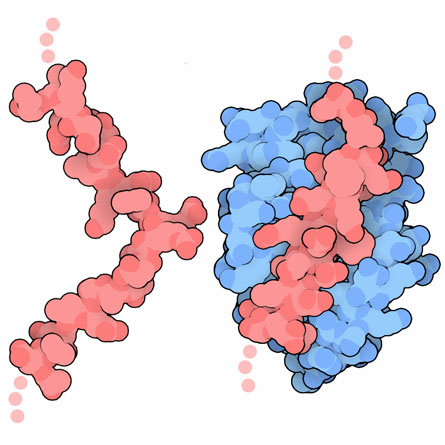Disordered Proteins: Unlocking the Enigma of Flexibility in Molecular Biology
The exploration of protein structures has typified much of molecular biology’s narrative. Traditionally, proteins were perceived as rigid entities, adhering strictly to fixed three-dimensional configurations. This paradigm, however, has undergone a seismic shift in recent years. Researchers have come to appreciate the intricate nuances of disordered proteins—molecules that resist crystallization and instead display inherent flexibility. This flexibility is not merely an aberration but rather a fundamental characteristic that plays pivotal roles in cellular function, signaling, and therapeutic innovation.
The Protean Nature of Disordered Proteins
Disordered proteins, often referred to as intrinsically disordered proteins (IDPs), defy the conventional rigid structure that defines many proteins. Their conformational adaptability allows them to engage in a myriad of interactions, often transitioning between different structural states depending on the context. The inherent disorder within these proteins can range from complete lack of a defined stable structure to partially ordered regions. This variability imbues them with unique functional attributes that serve critical roles within various biological processes.
Structural ambiguity in these proteins means that they can interact with multiple partners. This promiscuity enables them to act as molecular hubs, orchestrating complex signaling pathways that are essential for the maintenance of cellular homeostasis. Indeed, disordered proteins have been identified in key signaling pathways, cell cycle regulation, and even transcriptional control. The dynamic nature of these molecules suggests an evolutionary advantage; their flexibility allows for rapid adaptability to environmental changes and cellular demands.
The Role of Disordered Proteins in Disease: A Double-Edged Sword
Despite their functional significance, disordered proteins are often implicated in a range of diseases. Their tendency to misfold or aggregate poses risks that can lead to pathological conditions. For instance, proteins associated with neurodegenerative diseases—including Alzheimer’s, Parkinson’s, and Huntington’s—often exhibit regions of intrinsic disorder. The aggregation of these proteins, driven by abnormal conformational changes, is a hallmark of these diseases, resulting in cellular dysfunction and ultimately, cell death.
This duality poses a compelling conundrum; while flexibility can confer adaptive advantages, it can also lead to deleterious states. Consequently, understanding the precise mechanisms through which disordered proteins contribute to both normal physiology and disease pathophysiology thus emerges as a critical area of interest in contemporary biology. By elucidating these mechanisms, novel therapeutic strategies may be developed that target the pathways involved in protein misfolding and aggregation, harnessing the benefits of disordered proteins while mitigating their potential hazards.
Pioneering Research: Disordered Proteins in Therapeutics
Harnessing the properties of disordered proteins presents uncharted avenues for therapeutic intervention. Researchers are increasingly pursuing the potential of IDPs in drug design. Their capacity for multiple, transient interactions allows for the design of small molecules or peptides that can selectively modulate these interactions without necessarily demanding structural rigidity. This flexibility offers a more nuanced approach to regulation and therapeutic targeting than traditional rigid protein targets.
Recent studies have highlighted the role of disordered proteins in cancer biology. The aberrant expression of certain IDPs is frequently observed in various cancer types, leading to hyperactivation of oncogenic pathways. Targeting the disordered regions of these proteins offers a unique opportunity to disrupt their function selectively. Advances in techniques such as intercepting protein-protein interactions (PPIs) have been pivotal in this aspect, allowing for the development of compounds that can inhibit the oncogenic signaling cascades mediated by disordered proteins.
Additionally, the role of protein disorder in the immune response underscores another promising therapeutic trajectory. Disordered regions in immune signaling proteins can facilitate rapid responses to pathogens, guiding the development of vaccines or immunotherapies that leverage the adaptability of these biomolecules. The striking ability of IDPs to engage dynamically with evolving protein structures presents exciting possibilities for pharmaceutical innovation.
A Paradigm Shift: Rethinking Protein Functionality
Recognizing the importance of disordered proteins compels a re-examination of how we comprehend biochemistry and molecular interactions. The classical view of protein functionality—anchored in the understanding of globular, well-folded proteins—is being enhanced by this newfound awareness of disorder. By dispelling the notion of rigid conformity in protein structures, the scientific community is progressively adopting a more nuanced perspective of molecular interaction dynamics.
This shift in thought encapsulates a broader narrative about the inherent complexity of life at the molecular level. It underscores the necessity for scientists to adopt interdisciplinary approaches that transcend traditional boundaries. Insights from biophysics, computational biology, and structural bioinformatics converge to yield a deeper understanding of protein behavior and functionality. This holistic view not only enriches our foundational knowledge but also enhances our ability to devise solutions to biological puzzles.
Curiously, this rethinking also extends into developmental biology. Disordered proteins have been implicated in the intricate processes governing embryonic development. Their ability to mediate complex networks of signaling pathways is essential in delineating cellular fates during differentiation. Understanding these roles offers exciting prospects for regenerating tissues and developing therapies for developmental disorders.
Conclusion: The Future of Disordered Proteins
As research continually evolves, disordered proteins are emerging as a focal point of investigation in molecular biology. The flexibility, adaptability, and role in cellular dynamics promise profound implications for both basic science and therapeutic innovation. Their dual role in functionality and disease presentation evokes a sense of intrigue that beckons further exploration, posing a series of questions about the limits of our current understanding of protein structure and function.
In this uncharted territory, the dialogue surrounding disordered proteins cultivates a fertile ground for inquiry, interlinking molecular biology with therapeutic development. It propels the scientific community towards not only understanding but capitalizing on this molecular flexibility as a tool for innovation in biology and medicine. As we continue to peel back the layers of complexity surrounding these enigmatic molecules, the potential for groundbreaking discoveries and advancements in understanding the very fabric of life becomes increasingly tangible.
